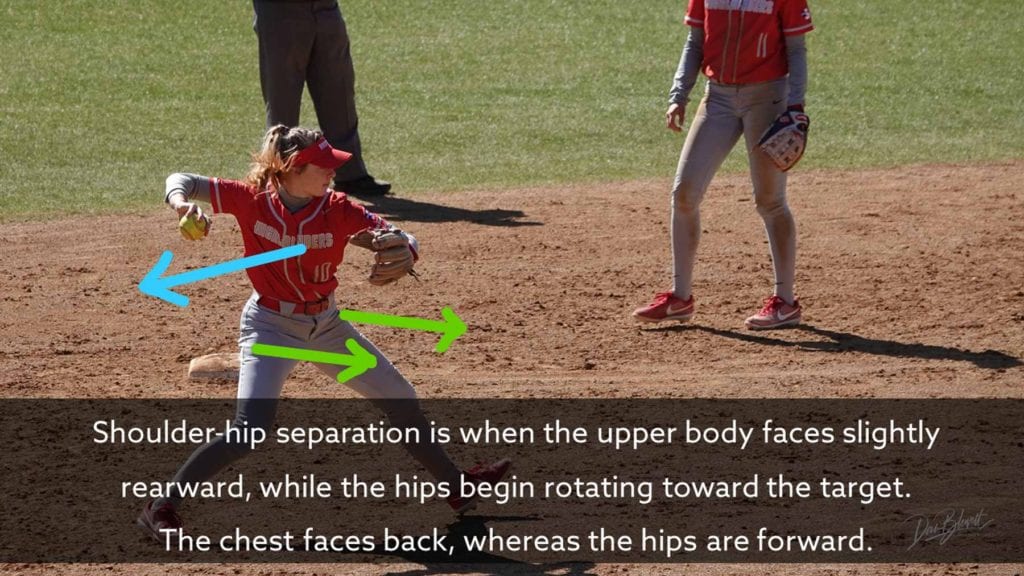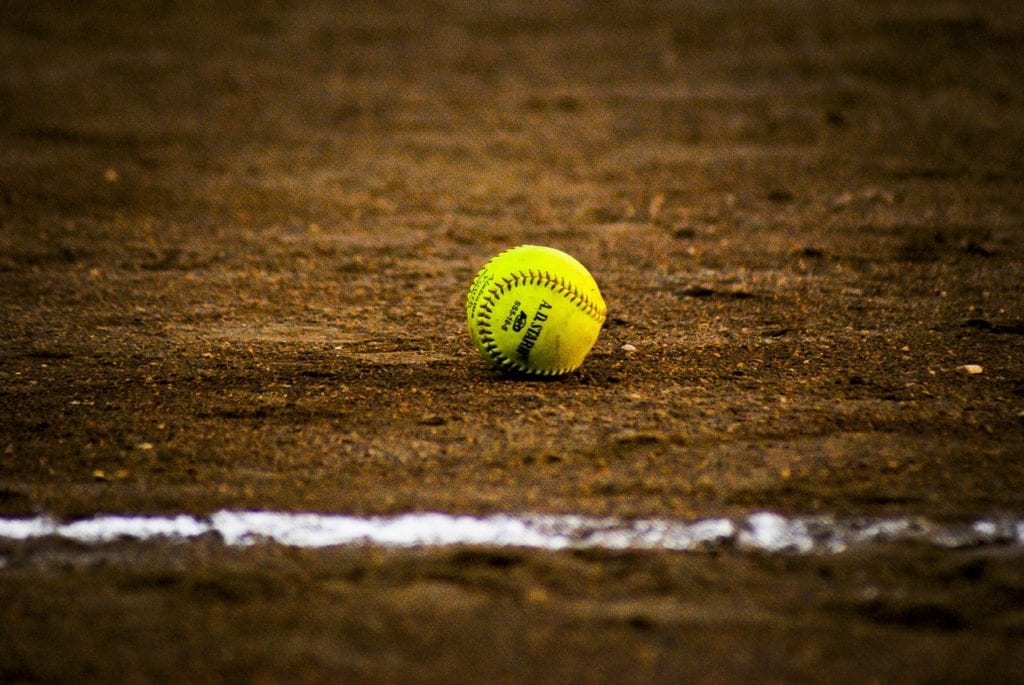*This article may contain product links which pay me a small commission if you make a purchase. Learn more.
Slow pitch softball throwing drills can make a huge difference in a player’s game. Though many slow pitch players have a background in baseball or softball, many do not, making even fundamental skills a challenge to learn in adulthood. Playing recreational softball is all about having fun, meeting new people, competing and getting out in the sun. But, when you have the requisite skills to make the routine play consistently, the game gets a lot more fun. Read on fore four great tips for improving your slow pitch throwing skills.
First: A New Video on 7 Ways to Improve Your Throwing
Be sure to check out this video on my YouTube channel, and jump over to slowpitchskills.com for my free throwing webinar.
Slow Pitch Throwing Drill #1: The Lawnmower Drill
A common flaw in most players’s slow pitch throwing mechanics is that their throwing shoulder blade doesn’t retract–or pinch–enough behind the body as the hips and core begin to rotate. Throwing is very much a whole-body skill, and when the shoulder blades pinch behind the the body, they “hitch up” with the rest of the body, so to speak.
For more on the role of the shoulder blades in slow pitch throwing mechanics, please watch the short video below.
Most players who don’t have strong arms as adults exhibit this flaw, but the good news it can be improved with the right drills and repetition.
Using the lawnmower throwing drill below specifically addresses pinching the shoulder blades.
The lawnmower drill is a great choice for players who want to improve their throwing speed in slow pitch and exhibit a bit of a “pushy” elbow.

Slow Pitch Throwing Drill #2: Proper Infield Footwork
Footwork is a major part of improving your throwing mechanics, and fixing your infield footwork is one of the most important tips I can give you. Basically, the infield “crowhop” is like the tires on a car – no matter how powerful the engine, with flat tires…you’re going nowhere.

Good fielding footwork sets the stage for a few things:
- Create momentum toward your target (a moving body throws harder than a stationary body)
- Get the hips facing sideways (perpendicular) to your target
- Set the stage for proper shoulder-hip separation, which is a chief way you’ll get power from your whole body
To improve your infield crowhop–which will directly improve your slow pitch throwing mechanics–follow the techniques in the video below.
Don’t overlook your fielding technique and footwork! It’s much more important than you might have realized.
To learn more about shoulder-hip separation, read on. Or, jump forward to the next drill if you’re not as concerned with the why behind the technique.
Shoulder-Hip Separation: Getting the Chest to Face Perpendicular to the Target
Shoulder-hip separation is basically the way the body generates power in both a swing and a throw. The lower half and upper half move in slight asynchrony, with the lower body (hips) rotating first, with the upper body (shoulders) lagging behind.

If you have kids, nieces or nephews, what you’ll notice when they’re 2 or 3 years old is that they move their entire body when they throw – their hips and torso moves as a unit. It’s an awkward looking throw that uses a lot of arm and doesn’t utilize the power of the hips and core.
As kids get older, their bodies usually figure out naturally how to separate the two halves to get more power. Humans are naturally pretty darned decent at throwing, and this concept doesn’t have to be explicitly taught (though we all know some athletes pick up skills faster than others).
Watch the 5-minute video below for a greater explanation of this, and why it’s critical.
I’m a firm believer in helping others understand the why behind what I teach, so be sure to come back to this video if you don’t have time to watch it today.
Slow Pitch Throwing Drill #3: Getting the Grip Right
Okay, so this isn’t exactly a drill, but your grip does matter quite a bit. Basically, if your fingers are too far apart, they’ll put sidespin on your throws by accident. Getting poor spin on the ball will cause the following:
- It will reduce your throwing velocity by 2-3 mph immediately
- This is because you’re not putting all of your arm’s force through the center of the ball. It’s just like hitting a line drive – when all the force of the bat lines up with the center of the ball, you crush it. When you hit the top or bottom, it doesn’t leave the bat with nearly the same speed.
- It will cause your throw to veer off target
- Sidespin will make the ball wander off-target, usually to the player’s glove side
- It will drop faster and not carry as far
- Good backspin on a throw essentially resists falling back to the earth as fast – it creates a little bit of lift, a lot like an airplane. When you add sidespin to the mix accidentally, it won’t carry nearly as far without good backspin.
Watch the video below for more on the grip – this is important, I promise!
One thing to remember – you don’t try to grab the ball in any particular orientation when fielding a grounder or fly ball during a game – you just grab it and chuck it. But, getting your fingers on the ball as I show above is very important.
Bonus Throwing Drill: How to Perform the Feed Throw to 2nd
The softball field is small, and so throws to second base from the shortstop or second baseman have to be quick. But, these throws can be very awkward when made overhand. This throw should be made sidearm when possible, but it’s a bit of an advanced (though not difficult) technique for those without a background in higher level baseball or softball.
If you play the infield for your slow pitch softball team, having this throw in your repertoire will be a huge advantage.
Slow Pitch Softball Throwing Doesn’t Have to Be So Hard.
If you’re a slow pitch softball player and struggle with throwing, I can help.
As a former pro baseball pitcher, I owned a baseball and softball academy for nearly a decade before selling the business to transition into more online instruction, speaking and clinics. I’ve taught for thousands of hours to hundreds of high level players in both sports, and enjoy teaching beginners just the same.
I’m based in Washington, DC but do clinics all over.
If you or your team could use help, shoot me an email and tell me what you need.

More Slow Pitch Softball Throwing Resources
I have lots of free information on the web:
- My Snap Softball YouTube Channel – full of helpful, free throwing videos
- Slowpitchskills.com – my dedicated softball website with free articles and videos
- Courses.Danblewett.com – I offer online courses for softball throwing, mental skills and baseball pitching
- The Baseball Doctor Hitting Channel – I know it’s not softball, but hitting is hitting and I think this guy does a great job teaching hitting mechanics and drills
My New Workout Program – Early Work Softball Training
Sign up for a free trial of the Early Work Online Strength Program today – two versions, suitable for any age or ability!
What's the First Thing I Should do to Improve My Throwing in Slow Pitch Softball?
Start with your footwork – be sure your fielding technique and crowhop is sound, because this will put your body in the best position to throw with good mechanics. Then, be sure to address your shoulder blades – as the hands separate, the throwing arm shoulder blade should pinch back, behind the body. The hands should separate downward as this pinching action begins. Those are two great first steps to take.
Why Does My Arm Hurt in Softball?
Arm pain when throwing a softball is often a product of a few factors:
1. Poor throwing mechanics
2. Poor shoulder and rotator cuff strength
3. Poor footwork and a lack of momentum, which forces the arm to work harder
4. Overuse – throwing is a repetitive motion, so be sure to perform restorative arm care exercises for the shoulder and get proper rest between games.
Does Overall Fitness Impact Slow Pitch Softball Throwing Mechanics?
Yes. I realize that slow pitch softball is a recreational sport, and many players won’t be spending a lot of time preparing to play. Yet, the best athletes in any sport are athletes first, meaning that they’re very physically fit and have an appropriate playing weight for their frame. I’ve coached overweight athletes who simply didn’t move well because of their weight, and the best “mechanics” tips I could give them was dropping some of their bad weight.
